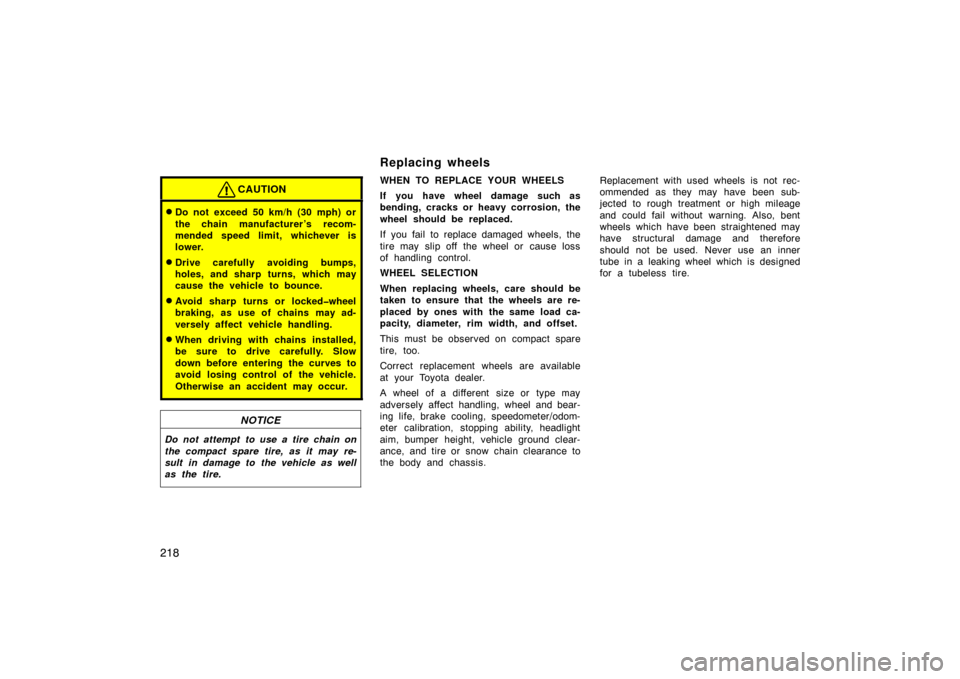Page 231 of 258

218
CAUTION
�Do not exceed 50 km/h (30 mph) or
the chain manufacturer ’s recom-
mended speed limit, whichever is
lower.
�Drive carefully avoiding bumps,
holes, and sharp turns, which may
cause the vehicle to bounce.
�Avoid sharp turns or locked�wheel
braking, as use of chains may ad-
versely affect vehicle handling.
�When driving with chains installed,
be sure to drive carefully. Slow
down before entering the curves to
avoid losing control of the vehicle.
Otherwise an accident may occur.
NOTICE
Do not attempt to use a tire chain on
the compact spare tire, as it may re-
sult in damage to the vehicle as well
as the tire.
WHEN TO REPLACE YOUR WHEELS
If you have wheel damage such as
bending, cracks or heavy corrosion, the
wheel should be replaced.
If you fail to replace damaged wheels, the
tire may slip off the wheel or cause loss
of handling control.
WHEEL SELECTION
When replacing wheels, care should be
taken to ensure that the wheels are re-
placed by ones with the same load ca-
pacity, diameter, rim width, and offset.
This must be observed on compact spare
tire, too.
Correct replacement wheels are available
at your Toyota dealer.
A wheel of a different size or type may
adversely affect handling, wheel and bear-
ing life, brake cooling, speedometer/odom-
eter calibration, stopping ability, headlight
aim, bumper height, vehicle ground clear-
ance, and tire or snow chain clearance to
the body and chassis.Replacement with used wheels is not rec-
ommended as they may have been sub-
jected to rough treatment or high mileage
and could fail without warning. Also, bent
wheels which have been straightened may
have structural damage and therefore
should not be used. Never use an inner
tube in a leaking wheel which is designed
for a tubeless tire.
Replacing wheels
Page 235 of 258

222
CAUTION
AUXILIARY BATTERY PRECAUTIONS
When the auxiliary battery must be
replaced, use the Prius designated
battery.
The auxiliary battery produces flam-
mable and explosive hydrogen gas.
�Do not cause a spark from the bat-
tery with tools.
�Do not smoke or light a match near
the battery.
The electrolyte contains poisonous
and corrosive sulfuric acid.
�Avoid contact with eyes, skin or
clothes.
�Never ingest electrolyte.
�Wear protective safety glasses when
working near the battery.
�Keep children away from the bat-
tery.
EMERGENCY MEASURES
�If electrolyte gets in your eyes,
flush your eyes with clean water
and get immediate medical atten-
tion. If possible, continue to apply
water with a sponge or cloth while
en route to the medical office.
�If electrolyte gets on your skin,
thoroughly wash the contact area. If
you feel pain or burn, get medical
attention immediately.
�If electrolyte gets on your clothes,
there is a possibility of its soaking
through to your skin, so immediate-
ly take off the exposed clothing and
follow the procedure above, if nec-
essary.
�If you accidentally swallow electro-
lyte, drink a large quantity of water
or milk. Follow with milk of magne-
sia, beaten raw egg or vegetable
oil. Then go immediately for emer-
gency help.
�Warning: Battery posts, terminals and
related accessories contain lead and
lead compounds, chemicals known to
the State of California to cause can-
cer and reproductive harm. Wash
hands after handling.
Terminals
Ground cable
Hold−down clamp
Check the battery for corroded or loose
terminal connections, cracks, or loose
hold�down clamp.
a. If the battery is corroded, wash it off with a solution of warm water and bak-
ing soda. Coat the outside of the termi-
nals with grease to prevent further cor-
rosion.
b. If the terminal connections are loose, tighten their clamp nuts—but do not
overtighten.
c. Tighten the hold− down clamp only
enough to keep the battery firmly in
place. Overtightening may damage the
battery case.
Checking auxiliary battery
condition—
—Precautions —Checking auxiliary battery
exterior
Page 251 of 258

238
90p006a
Engine compartment
8. AM2 15 A: Starting system, multiport
fuel injection system/sequential multi-
port fuel injection system, hybrid ve-
hicle immobiliser system
9. THRO 15 A: Electronic throttle control
system
10. HEAD (RH) (Vehicles without DAY- TIME RUNNING LIGHT SYSTEM) or
HEAD LO (RH) (Vehicles with DAY-
TIME RUNNING LIGHT SYSTEM) 10
A: Right −hand headlight
11. HEAD HI (LH) (Vehicles without DAY- TIME RUNNING LIGHT SYSTEM) 10
A: Left −hand headlight (high beam)
90p007a
Instrument panel
12. BATT FAN 10 A: Battery cooling fan
13. ABS NO.3 20 A: Hydraulic brake
booster
14. HV 20 A: Hybrid system
15. EFI 15 A: Multiport fuel injection sys-
tem/sequential multiport fuel injection
system
16. HEAD (LH) (Vehicles without DAY- TIME RUNNING LIGHT SYSTEM) or
HEAD LO (LH) (Vehicles with DAY-
TIME RUNNING LIGHT SYSTEM) 10
A: Left −hand headlight
90p008a
Trunk
17. DOME 15 A: Audio system, mult −infor-
mation display, interior light, trunk light,
power window system, wireless remote
control system
18. TURN�HAZ 10 A: Turn signal lights,
Emergency flasher
19. PANEL 5 A: Audio system, ashtray
light, headlight beam level control sys-
tem, emergency flasher
20. GAUGE 10 A: Gauge and meter, emer-
gency flasher, rear window defogger,
service reminder indicator and warning
buzzers, back− up light, power window
system, air c onditioning system
Page 252 of 258

239
21. HTR 10 A: Air conditioning system
22. TAIL 7.5 A: Parking lights, tail lights,
license plate lights, side marker lights
23. ECU�IG 5 A: Air conditioning system,
anti −lock brake system, electric power
steering, daytime running light system
24. STOP 15 A: Stop lights, high mounted
stoplights, anti −lock brake system
25. ACC 10 A: Anti−lock brake system
warning light, clock, audio system, mul-
ti −information display, shift lock system
26. WIPER 30 A: Windshield wiper
27. ECU�B 7.5 A: Air conditioning system,
daytime running light system, electric
power steering system, hybrid vehicle
immobiliser system
28. CIG 15 A: Power outlet
29. WASHER 15 A: Washer
30. DOOR 30 A: Power door lock system
31. SRS ACC 10 A: SRS airbags, seat
belt pretensioners
32. OBD II 7.5 A: No circuit
33. PWR1 20 A: Power window system
34. AM1 5 A: “ACC”, “CIG”, “SRS ACC”,
“WASHER”, “HTR”, “WIPER”, “ECU −IG”
and “GAUGE” fuses
35. DC/DC�S 5 A: Inverter and converter 36. HTR NO.3 50 A:
Air conditioning sys-
tem
37. EMPS 50 A: Electric power steering
38. ABS NO.1 40 A: Anti−lock brake sys-
tem
39. MF HEAD 30 A: Daytime running light
system
40. HTR 50 A: Air conditioning system
41. RDI 30 A: Electric cooling fan
42. ABS NO.2 30 A: Hydraulic brake
booster